Sealing element for use in a fluid-flow machine
- Summary
- Abstract
- Description
- Claims
- Application Information
AI Technical Summary
Benefits of technology
Problems solved by technology
Method used
Image
Examples
Embodiment Construction
[0047]In FIG. 1, a gas turbine 1 known from the prior art is represented in a schematized representation. Such gas turbines are used for example in power generating plants for generating electric power and represent a typical area of application of the invention. The sealing element formed according to the invention may, however, also be used in fluid-flow machines used in other ways, such as for example in fluid-flow machines which are used in process plants or for generating propulsive power.
[0048]The gas turbine 1 comprises as essential components, represented in FIG. 1, a compressor 2, a combustion chamber 3 and a turbine 4. The compressor 2 and the turbine 4 are connected to each other in a rotationally fixed manner by means of a shaft 5. Furthermore, the compressor 2, the combustion chamber 3 and the turbine 4 form a flow path, which is indicated in FIG. 1 by the flow arrow 6. During the operation of the gas turbine 1, a working fluid, usually air, flows along the flow path th...
PUM
 Login to View More
Login to View More Abstract
Description
Claims
Application Information
 Login to View More
Login to View More - R&D
- Intellectual Property
- Life Sciences
- Materials
- Tech Scout
- Unparalleled Data Quality
- Higher Quality Content
- 60% Fewer Hallucinations
Browse by: Latest US Patents, China's latest patents, Technical Efficacy Thesaurus, Application Domain, Technology Topic, Popular Technical Reports.
© 2025 PatSnap. All rights reserved.Legal|Privacy policy|Modern Slavery Act Transparency Statement|Sitemap|About US| Contact US: help@patsnap.com



